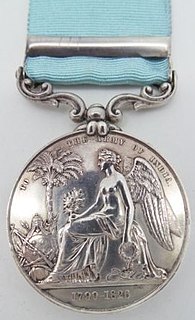 W
WThe Army of India Medal (AIM) was a campaign medal approved in 1851 for issue to officers and men of the British Army and the Army of the Honourable East India Company. A retrospective award following the precedent set by the Naval General Service Medal and the Military General Service Medal, it served to reward service in various actions from 1803 to 1826.
 W
WThe Burma Medal is a campaign medal awarded by the Governor-General of India to native Indian soldiers of the armies of the Honourable East India Company (HEIC) who participated in the First Burma War from April 1824 to February 1826.
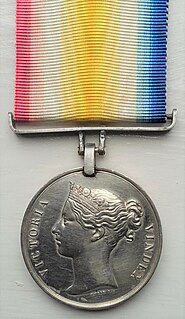 W
WThe Candahar, Ghuznee, Cabul Medal was awarded to those who took part in the campaign in the spring and summer of 1842, under the command of General William Nott, to restore British standing in Afghanistan after earlier defeats during the First Anglo-Afghan War.
 W
WThe Capture of Ceylon Medal is a campaign medal that was awarded by the Governor-General of India to soldiers in Bengal artillery units of the armies of the East India Company (EIC) who took part in the capture of Ceylon in 1795–96.
 W
WThe Coorg Medal was awarded by the Honourable East India Company (HEIC) to local forces who remained loyal during the Coorg rebellion of 1837.
 W
WThe Deccan Medal was the first campaign medal instituted by the East India Company (EIC). It was awarded to native Indian troops who took part in the major campaigns in India between 1778 to 1784. It is sometimes referred to as the Carnatic Medal.
 W
WThe Egypt Medal is a campaign medal that was awarded by the Governor-General of India to members of the expeditionary force that travelled from India to take part in the 1801 Egyptian campaign, a part of the French Revolutionary Wars.
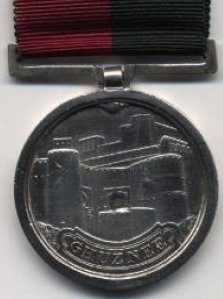 W
WThe Ghuznee Medal is a British campaign medal awarded for participation in the storming of the fortress of Ghuznee in Afghanistan, on 21 to 23 July 1839 by troops of the British and Indian Armies. This action, the Battle of Ghazni, took place during the First Anglo-Afghan War.
 W
WThe Gwalior Star is a Campaign medal presented by the Honourable East India Company to the soldiers of the British Army and the British led Bengal Army who took part in the 1843 Gwalior Campaign.
 W
WThe Java Medal is a campaign medal awarded by the Governor-General of India to soldiers of the armies of the Honourable East India Company (HEIC) who participated in the Invasion of Java in August and September 1811, during the Napoleonic Wars.
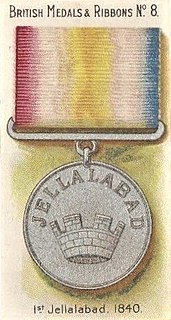 W
WThe Jellalabad Medal, a campaign medal issued by the British East India Company. It was established by George Eden, the Governor-General of India, on 30 April 1842.The medal was awarded for the defence of Jalalabad from 12 November 1841 to 7 April 1842, during the First Afghan War, to the troops under the command of Sir Robert Sale. About 2,600 soldiers took part, including the 13th Foot, the 35th Bengal Native Infantry, as well as detachments from other Indian Army units and some loyal Afghan forces.
 W
WThe Medal for the capture of Rodrigues, Isle of Bourbon and Isle of France is a campaign medal that was awarded by the Governor-General of India to native Indian soldiers of the East India Company (EIC), who took part in the capture of these three Indian Ocean islands from French forces between July 1809 and December 1810.
 W
WThe Kelat-I-Ghilzie Medal is a campaign medal issued by the British East India Company, to the defenders of the fort at Kelat-I-Ghilzie during the First Anglo-Afghan War.
 W
WThe Monghyr Mutiny Medal is a possible early campaign medal of the British East India Company. Robert Clive is known to have decorated a number of sepoys for their service in the Monghyr Mutiny. A campaign medal is listed in some sources as having been awarded, and both the National Army and Victoria and Albert Museums hold a medal depicting Minerva, which they attribute to this action. Other sources dispute this and identify the Minerva medal as being awarded by a Freemasons lodge in Leipzig. If awarded, the medal would have been the earliest of those issued by the company in India.
 W
WThe Mysore Medal is a campaign medal that was awarded by the Governor-General of India to native Indian soldiers of the armies of the Honourable East India Company (HEIC) who participated in the Third Anglo-Mysore War of 1790 to 1792.
 W
WThe Nepal Medal was awarded by the Honourable East India Company (HEIC) to native Indian officers, and Indian soldiers for particularly distinguished conduct, during the Anglo-Nepalese War of 1814–16.
 W
WThe Order of British India was an order of merit established in 1837 by the East India Company for "long, faithful and honourable service". The company's powers were removed after the Indian Mutiny, and the Order was incorporated into the British Honours System in 1859. The order became obsolete in 1947, after the partition of British India into the Dominion of India and the Dominion of Pakistan.
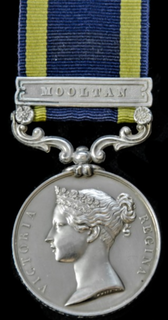 W
WThe Punjab Medal was a campaign medal issued to officers and men of the British Army and Honourable East India Company who served in the Punjab campaign of 1848-49, which ended in the British annexation of the Punjab.
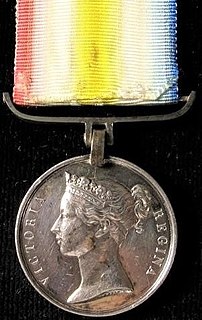 W
WThe Scinde Medal was authorised on 22 September 1843 and issued to soldiers of the Honourable East India Company, the 22nd Regiment of Foot of the British Army and members of the Indian Navy who manned the Indus Flotilla, who participated in Major General Sir Charles Napier's conquest of Scinde between 1842 and 1843.
 W
WThe Seringapatam Medal, or Sri Ranga Pattana, is a campaign medal that was awarded by the Governor-General of India to all British and Indian soldiers who participated in the British victory in the Battle of Seringapatam in 1799.
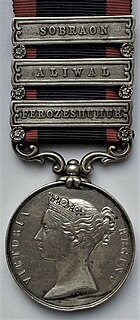 W
WThe Sutlej Medal was a campaign medal approved in 1846, for issue to officers and men of the British Army and Honourable East India Company who served in the Sutlej campaign of 1845-46. This medal was the first to use clasps to denote soldiers who fought in the major battles of the campaign.